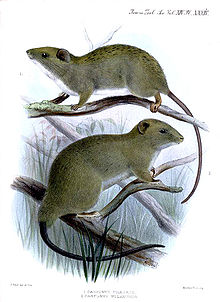Short-footed Luzon tree rat
| Short-footed Luzon tree rat | |
|---|---|
 | |
Carpomys melanurus (below) with C. phaeurus (above) | |
Conservation status | |
 Data Deficient (IUCN 3.1)[1] | |
Scientific classification | |
| Kingdom: | Animalia |
| Phylum: | Chordata |
| Class: | Mammalia |
| Order: | Rodentia |
| Family: | Muridae |
| Genus: | Carpomys |
| Species: |
C. melanurus |
Binomial name | |
Carpomys melanurus Thomas, 1895 | |
The short-footed Luzon tree rat or greater dwarf cloud rat (Carpomys melanurus) is a species of rodent in the family Muridae.[2] It is found only in the Philippines, specifically in northern Luzon. Its natural habitat is tropical moist montane forests.[1]
This species was long thought to be extinct. In 2008, Filipino researchers including Dr. Danilo Balete found a specimen in the canopy of Mount Pulag National Park, the first scientifically observed individual of the species since 1896.[3] The captured individual was "about 185 grams and has dense soft reddish-brown fur, a black mask around large dark eyes, small rounded ears, a broad and blunt snout and a long tail covered with dark hair".[3]
References
^ ab Heaney, L., Balete, D., Rosell-Ambal, G., Tabaranza, B. & Ong, P. (2008). "Carpomys melanurus". IUCN Red List of Threatened Species. IUCN. 2008: e.T3917A10172176. Retrieved 23 November 2015.CS1 maint: Uses authors parameter (link) .mw-parser-output cite.citation{font-style:inherit}.mw-parser-output q{quotes:"""""""'""'"}.mw-parser-output code.cs1-code{color:inherit;background:inherit;border:inherit;padding:inherit}.mw-parser-output .cs1-lock-free a{background:url("//upload.wikimedia.org/wikipedia/commons/thumb/6/65/Lock-green.svg/9px-Lock-green.svg.png")no-repeat;background-position:right .1em center}.mw-parser-output .cs1-lock-limited a,.mw-parser-output .cs1-lock-registration a{background:url("//upload.wikimedia.org/wikipedia/commons/thumb/d/d6/Lock-gray-alt-2.svg/9px-Lock-gray-alt-2.svg.png")no-repeat;background-position:right .1em center}.mw-parser-output .cs1-lock-subscription a{background:url("//upload.wikimedia.org/wikipedia/commons/thumb/a/aa/Lock-red-alt-2.svg/9px-Lock-red-alt-2.svg.png")no-repeat;background-position:right .1em center}.mw-parser-output .cs1-subscription,.mw-parser-output .cs1-registration{color:#555}.mw-parser-output .cs1-subscription span,.mw-parser-output .cs1-registration span{border-bottom:1px dotted;cursor:help}.mw-parser-output .cs1-hidden-error{display:none;font-size:100%}.mw-parser-output .cs1-visible-error{font-size:100%}.mw-parser-output .cs1-subscription,.mw-parser-output .cs1-registration,.mw-parser-output .cs1-format{font-size:95%}.mw-parser-output .cs1-kern-left,.mw-parser-output .cs1-kern-wl-left{padding-left:0.2em}.mw-parser-output .cs1-kern-right,.mw-parser-output .cs1-kern-wl-right{padding-right:0.2em}
^ Musser, G.G.; Carleton, M.D. (2005). "Superfamily Muroidea". In Wilson, D.E.; Reeder, D.M. Mammal Species of the World: A Taxonomic and Geographic Reference (3rd ed.). Johns Hopkins University Press. pp. 894–1531. ISBN 978-0-8018-8221-0. OCLC 62265494.
^ ab "Mammal believed extinct found in mossy forest". CBC News. 2008-05-02. Retrieved 2008-05-02.
| Wikimedia Commons has media related to Carpomys melanurus. |
This Murinae article is a stub. You can help Wikipedia by expanding it. |

Comments
Post a Comment